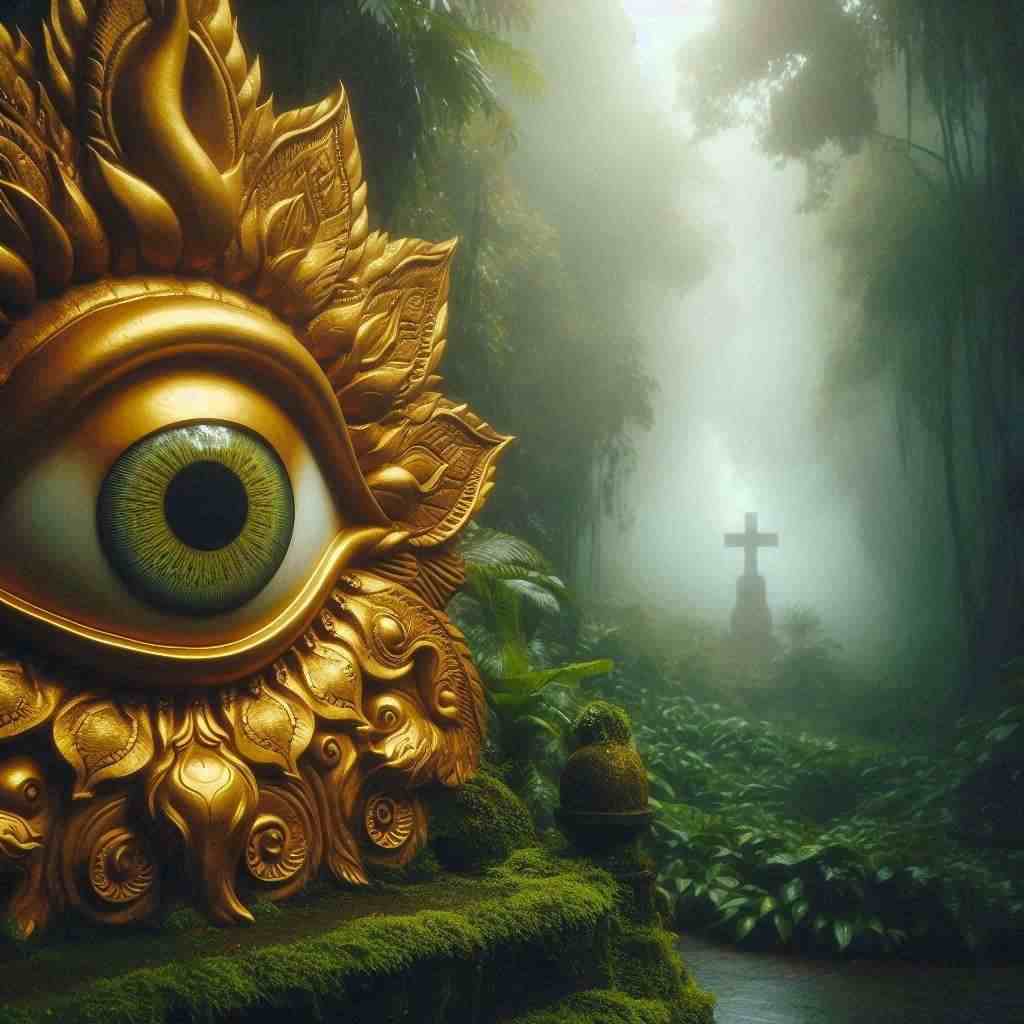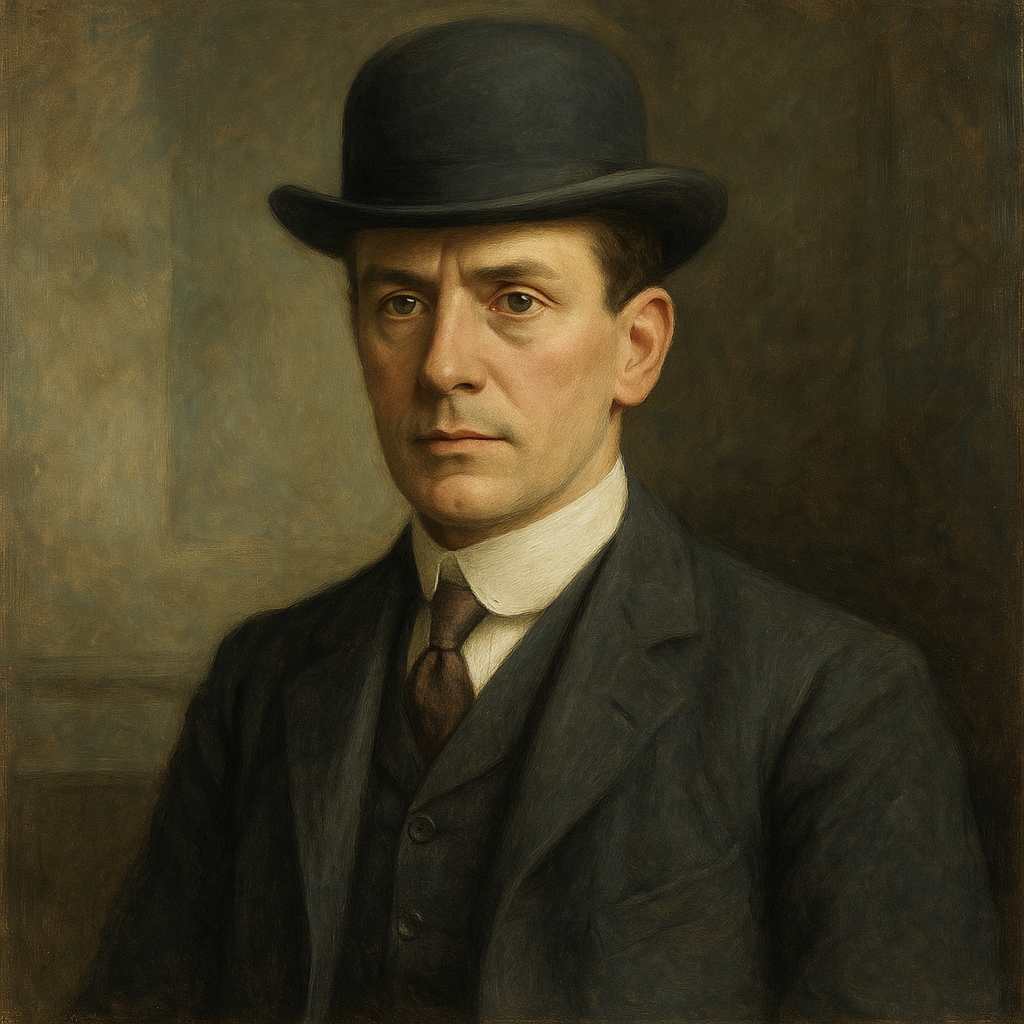The Green Eye of the Little Yellow God
J. Milton Hayes
1893 to 1940

There’s a one-eyed yellow idol to the north of Khatmandu,
There’s a little marble cross below the town;
There’s a broken-hearted woman tends the grave of Mad Carew,
And the Yellow God forever gazes down.
He was known as “Mad Carew” by the subs at Khatmandu,
He was hotter than they felt inclined to tell;
But for all his foolish pranks, he was worshipped in the ranks,
And the Colonel’s daughter smiled on him as well.
He had loved her all along, with a passion of the strong,
The fact that she loved him was plain to all.
She was nearly twenty-one and arrangements had begun
To celebrate her birthday with a ball.
He wrote to ask what present she would like from Mad Carew;
They met next day as he dismissed a squad;
And jestingly she told him then that nothing else would do
But the green eye of the little Yellow God.
On the night before the dance, Mad Carew seemed in a trance,
And they chaffed him as they puffed at their cigars:
But for once he failed to smile, and he sat alone awhile,
Then went out into the night beneath the stars.
He returned before the dawn, with his shirt and tunic torn,
And a gash across his temple dripping red;
He was patched up right away, and he slept through all the day,
And the Colonel’s daughter watched beside his bed.
He woke at last and asked if they could send his tunic through;
She brought it, and he thanked her with a nod;
He bade her search the pocket saying “That’s from Mad Carew,”
And she found the little green eye of the god.
She upbraided poor Carew in the way that women do,
Though both her eyes were strangely hot and wet;
But she wouldn’t take the stone and Mad Carew was left alone
With the jewel that he’d chanced his life to get.
When the ball was at its height, on that still and tropic night,
She thought of him and hurried to his room;
As she crossed the barrack square she could hear the dreamy air
Of a waltz tune softly stealing thro’ the gloom.
His door was open wide, with silver moonlight shining through;
The place was wet and slipp’ry where she trod;
An ugly knife lay buried in the heart of Mad Carew,
‘Twas the “Vengeance of the Little Yellow God.”
There’s a one-eyed yellow idol to the north of Khatmandu,
There’s a little marble cross below the town;
There’s a broken-hearted woman tends the grave of Mad Carew,
And the Yellow God forever gazes down.
J. Milton Hayes's The Green Eye of the Little Yellow God
Introduction
J. Milton Hayes' narrative poem "The Green Eye of the Little Yellow God" presents a captivating blend of exoticism, romance, and tragedy set against the backdrop of British colonial India. This analysis will delve into the poem's structure, themes, literary devices, and cultural context, exploring how Hayes crafts a tale that both entertains and subtly critiques the colonial mindset of its time.
Structure and Form
The poem consists of nine stanzas, each containing four lines with an ABAB rhyme scheme. This ballad-like structure contributes to the poem's storytelling quality, making it easy to recite and remember. The regular rhythm and rhyme create a sense of inevitability, mirroring the fatalistic tone of the narrative.
Hayes employs a framing device, opening and closing the poem with the same stanza:
There's a one-eyed yellow idol to the north of Khatmandu, There's a little marble cross below the town; There's a broken-hearted woman tends the grave of Mad Carew, And the Yellow God forever gazes down.
This circular structure emphasizes the timelessness of the story and the enduring nature of the Yellow God's presence, contrasting sharply with the fleeting lives of the human characters.
Themes
Exoticism and Orientalism
The poem is steeped in exoticism, presenting a romanticized and potentially problematic view of the East. The "one-eyed yellow idol" and the setting of Kathmandu evoke a sense of mystery and otherness that would have appealed to British readers of the time. This portrayal aligns with Edward Said's concept of Orientalism, where Western literature often depicted the East as exotic, mysterious, and sometimes dangerous.
Forbidden Desire and Transgression
The central conflict revolves around the desire for the forbidden – the green eye of the Yellow God. This desire, initially expressed playfully by the Colonel's daughter, leads to tragic consequences. The theme of transgression against local customs and beliefs by colonial figures is a recurring motif in literature of this period, often serving as a cautionary tale.
Love and Sacrifice
Mad Carew's actions are driven by his love for the Colonel's daughter. His willingness to risk his life to obtain the green eye demonstrates the depth of his feelings and the lengths to which he will go to please her. This theme of sacrificial love adds a romantic element to the narrative, complicating the otherwise straightforward adventure story.
Colonial Power Dynamics
While not explicitly critiquing colonialism, the poem subtly reveals the power dynamics at play in colonial India. The British characters, particularly Mad Carew, display a casual disregard for local religious artifacts, viewing them as mere curiosities or challenges to be overcome. This attitude reflects the broader colonial mindset of the time.
Literary Devices
Characterization
The poem's central character, Mad Carew, is vividly drawn despite the brevity of the piece. His nickname and reputation for "foolish pranks" establish him as a daring and unconventional figure. The contrast between his recklessness and his popularity among both his peers and the Colonel's daughter creates a complex and intriguing character.
Foreshadowing
Hayes employs foreshadowing throughout the poem to build tension and hint at the tragic ending. The nickname "Mad Carew" suggests a propensity for dangerous behavior. The description of the Colonel's daughter's eyes as "strangely hot and wet" after receiving the green eye hints at the emotional turmoil to come.
Imagery
The poem is rich in vivid imagery that brings the exotic setting to life. The "one-eyed yellow idol," the "little marble cross," and the "ugly knife" are all powerful visual elements that contribute to the poem's atmosphere of danger and mystery.
Irony
There is a strong element of irony in the fact that Carew's act of devotion – stealing the green eye – leads directly to his downfall. This irony is compounded by the fact that the Colonel's daughter ultimately rejects the gift, leaving Carew alone "With the jewel that he'd chanced his life to get."
Cultural and Historical Context
"The Green Eye of the Little Yellow God" was published in 1911, during the late period of British colonial rule in India. The poem reflects the fascination with the East that was prevalent in British culture at the time, as well as the complex relationships between colonizers and the colonized.
The character of Mad Carew represents a certain type of colonial figure – the daring, somewhat reckless young man seeking adventure in exotic lands. His disregard for local customs and religious artifacts would have been viewed as heroic by many contemporary readers, although modern interpretations might see it as emblematic of colonial arrogance.
The poem's popularity and enduring fame (it was often recited as a party piece well into the 20th century) speak to its appeal to the British public's appetite for tales of exotic adventure. However, it's important to note that this appeal was based on a romanticized and often inaccurate view of other cultures.
Critical Interpretation
While "The Green Eye of the Little Yellow God" can be read as a simple adventure story with a tragic ending, a deeper analysis reveals layers of meaning that reflect the complexities of the colonial experience.
The Yellow God itself can be interpreted as a symbol of the unknowable "Other" – the aspects of colonized cultures that remained mysterious and potentially threatening to the British. The act of stealing its eye represents the colonial desire to possess and control these cultures, but the tragic outcome suggests the futility and danger of such attempts.
Mad Carew's fate can be seen as a metaphor for the broader dangers of colonial overreach. His disregard for local beliefs and customs leads directly to his downfall, perhaps suggesting that the colonial project itself was fraught with peril.
The Colonel's daughter, while not the protagonist, plays a crucial role in the story. Her casual request for the god's eye sets the tragedy in motion, reflecting the sometimes thoughtless way in which colonial powers engaged with the cultures they encountered. Her rejection of the eye once obtained could be read as a belated recognition of the wrongness of the act, or simply as a failure to understand the magnitude of Carew's sacrifice.
Conclusion
J. Milton Hayes' "The Green Eye of the Little Yellow God" is more than just a melodramatic tale of adventure and tragedy. Through its vivid imagery, careful structure, and complex themes, it offers a window into the colonial mindset of early 20th century Britain. While its depiction of non-Western cultures is problematic by modern standards, the poem's enduring popularity speaks to its power as a narrative and its ability to capture the imaginations of readers.
The poem's subtle critiques of colonial attitudes, whether intentional or not, add depth to what might otherwise be a simple morality tale. By exploring the consequences of cultural transgression and the dangers of treating other cultures as mere sources of excitement or collectibles, Hayes creates a work that continues to invite analysis and interpretation more than a century after its publication.
In the end, the enduring gaze of the Yellow God serves as a reminder of the lasting impact of the colonial era, both on the colonized and the colonizers. The broken-hearted woman tending Mad Carew's grave becomes a symbol of the personal tragedies that played out against the backdrop of empire, while the idol's unblinking stare suggests the unyielding nature of the cultures that the British sought to understand and control.
This text was generated by AI and is for reference only. Learn more
Want to join the discussion? Reopen or create a unique username to comment. No personal details required!



Comments
No comments yet. Be the first to comment!